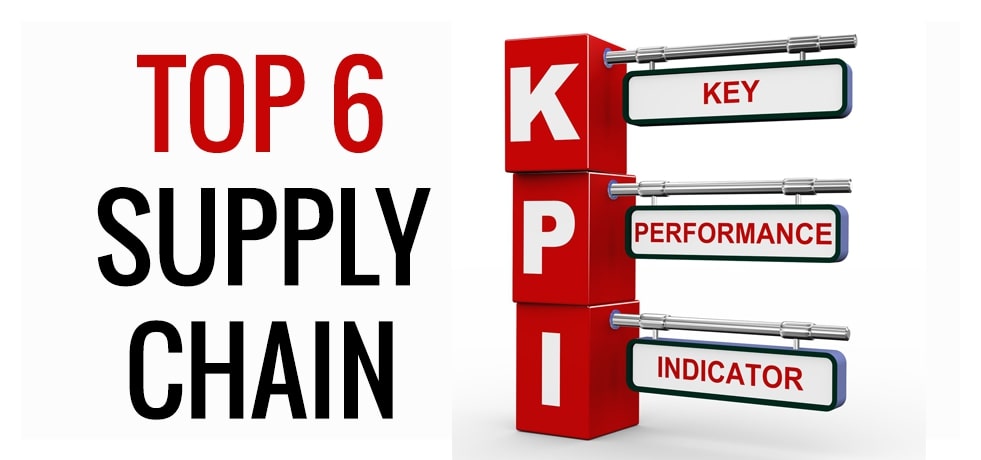Have you ever seen an image of the modern airliner’s flight deck? If you have, you know that even with the large multi-function displays located in front of the pilots, many other gauges and instruments seemingly demand attention—enough to make you wonder how the crew can monitor them all.
In reality, though, most of those instruments are there for reference in case of exceptions to normal flight conditions. So instead of keeping an eye on everything, airline pilots maintain a more or less continuous scan of five or six key indicators, all of which are visible on the multi-function display monitor.
The Supply Chain Manager’s Multi-function Display

By now, you are probably wondering what airliners have to do with supply chain KPIs. If so, please bear with us, because the link is not as tenuous as it might appear. You see, the set of primary data needed to keep an airliner aloft is (apparently) relatively simple—and the same is true of running a supply chain organisation.
It’s not uncommon though, for companies to make the mistake of over-complicating their supply chain performance monitoring.
While having too many KPIs is undoubtedly better than having none, it can impede progress by creating a confused, complex mass of information that becomes difficult to sort out and use as a basis for action. “Paralysis by analysis” is a common term used to describe such a situation, and you can avoid it by monitoring a smaller number of carefully chosen KPIs.
These key metrics become your organisation’s “multi-function display” and give you the primary data needed to monitor and manage “normal flight conditions.”
Feel free to track lots more metrics in the background if you wish, but try to keep attention focused on the five or six “real KPIs.” They will give you the most pertinent supply chain performance headlines at a glance.
The 6 Most Useful Supply Chain KPIs

It shouldn’t be too difficult to determine which KPIs to select for your multi-function display. However, every company and its supply chain is unique, so the information in this post is not intended to be prescriptive. Instead, it’s merely a common-sense guide to those supply chain KPIs that can best provide actionable data for general management purposes.
1. Perfect Order
Even if you chose no other KPIs for your supply chain organisation, you’d do well to consider perfect order as an absolute essential. Unlike most of the KPIs we recommend, perfect order is a composite of several elementary metrics.
Perfect order results can help you assess performance and diagnose issues impacting service, costs, and overall supply chain effectiveness.
The components of the perfect order KPI are as follows:
- On-time delivery: A calculation of the percentage of sales orders that arrive on time.
- In full delivery: This KPI tracks the percentage of sales orders that are delivered completely, meaning that the customer receives the correct items, in the right quantities.
- Damage-free delivery: This measurement is sometimes incorporated into the in full KPI, but can just also be a stand-alone metric.
- Accurate documentation: This metric tracks the percentage of sales orders accompanied by accurate documents throughout the process. Documents included in the metric can vary but usually include advance shipment notifications (ASNs), labels, and invoices.
As an example of how illuminating the perfect order KPI can be, let’s look briefly at damage-free delivery as an example.
If your company suffers from a low percentage of damage-free deliveries, you can safely assume that service suffers too, since customers are not receiving their orders in full.
In many cases, your distribution operation will incur unwanted costs to manage returns of damaged items and deliver replacements to the customers (not to mention the cost of writing off damaged inventory).
Finally, you have a problem with supply chain effectiveness, since the processes you have in place are ineffective in minimising inventory damages.
Each of the perfect order metrics provides similar insights into service, cost, and supply chain efficiency/effectiveness, which is why perfect order holds premiere position in our top six supply-chain KPIs.
Calculating the Perfect Order

So now you know about the components that together make up the perfect order composite measure, but as it heads our list of top KPIs, it’s probably worthy of a little more detail. Let’s start, then, with a look at the calculation.
To get to the perfect order percentage, you need to take the percentage of orders delivered on time, the percentage delivered in full, the percentage delivered free of damage, and the percentage accompanied by accurate documentation, and multiply them all together—then multiply the total by 100.
For example, if the on-time percentage is 98%, the in full is 93%, the damage-free is 99%, and the orders with correct documentation is 96%, the calculation will look like this…
0.98 x 0.93 x 0.99 x 0.96 = 0.8661. Multiply that by 100, and you get 86.61% as your perfect order percentage. Now you might notice that given the four separate performance percentages, which all seem very good, the final total for perfect order appears a bit disappointing—but such is the nature of this measurement.
One of the comments we often hear from our consulting clients, is how hard it is to get a high perfect order percentage—and it’s true. However, it’s vital to remember that the objective of KPIs is to drive improvement, not to have measurements that look impressive.
In other words, don’t worry about how difficult it might be to achieve a perfect-order score of 90% or higher. Set a realistic target that’s higher than your organization’s current performance, and shoot for that. If that target should be 80%, to improve upon a current score of 75%, so be it.
2. Fill Rate (Order Fill, Line Fill, Unit Fill)
While fill rate might be one of the components making up your perfect order KPI, it’s not a bad idea to keep track of order fill and line fill as KPIs in their own right, especially if in full performance is not trending above 98%.
Fill rate KPIs allow you to look a little more closely at in full performance. For example:
- Order fill monitors the percentage of orders successfully delivered on the first attempt
- Line fill monitors the percentage of order lines successfully delivered on the first attempt
- Unit fill monitors the percentage of items delivered on the first attempt
Feel free to choose the fill rate KPI that fits best with your operation, or use them all if it makes sense, but remember, the goal is to keep your multi-function display simple.
3. Cash to Cash Cycle Time
When a KPI has the word “cash” twice in its title, you might think it to be a purely financial KPI; but actually, cash to cash cycle time can also tell you about other aspects of supply chain health.
For example, suppose you can see the cycle time reducing. In that case, it’s a good indication that leanness is increasing—moreover, the less time your operating capital spends tied up, the greater your business’ profitability.
Cash-to-cash cycle time also serves as a guide to how well you are utilising your supply chain assets.
Calculate cash-to-cash cycle time by adding the number of days that inventory is on hand to the number of days (on average) that customers take to pay for their orders and deducting the number of days it typically takes for your organization to pay for its purchases.
As an example, if the number of day’s inventory on hand is 40, the number of day’s sales outstanding is 45, and the number of day’s payables outstanding is 30, the calculation would be as follows:
- 40 + 45 = 85 – 30 = 55, meaning your cash-to-cash cycle time is 55 days.
Naturally then, your target to set for the cash-to-cash cycle should be lower than your current cycle time, but you should take care not to let the number of day’s inventory on hand get too low, or you may run into customer service issues. Be aware, too, that suppliers may become a little disgruntled if you try to stretch the number of days’ payables too far.
4. Inventory Days of Supply
This KPI tells you the number of days your inventory would last without replenishment, before running out. The calculation requires the amount of inventory on hand to be divided by the average daily consumption of the same.
How to Calculate Inventory Days of Supply
Here is an example:
Total number of mobile phones in stock: 2,000
Average sales in a month: 600
Average daily sales: 600/30 = 20
Days of Supply: 2000/20 = 100 days
If you don’t get your estimations right, this KPI will impact your business negatively:
- If your estimations are higher than actual, an ‘out of stock’ situation could arise, leading to customer dissatisfaction, loss of customers, or even customers switching to other brands.
- If your estimations are lower than actual, it could lead to unnecessary and costly inventory replenishment, and in the case of manufacturing, it could result in overproduction.
- If you neglect this KPI altogether, in other words, do not make any estimations at all, it will be tantamount to shooting in the dark. The result could be constant shortages of stock, higher costs of running the business, or both.
Some guidelines for getting more accurate estimations:
1). Take into account cancellations and return of stock.
2). Allow for variations in sales due to seasons, festivals, and/or new trends.
3). Use weekly, monthly, and year-on-year data for your analysis.
4). Identify top products and ensure you have enough stock on hand to meet sudden surges in sales.
Bringing Suppliers on Board
Because there are costs involved in holding inventory—especially safety stock—it is prudent to negotiate optimum times for your suppliers to deliver to you. Once you have certainty that you can speed up replenishment times, you may want to consider lowering your inventory-days-of-supply metric to lower your costs.
The Par Level System
Some warehouse managers prefer to operate according to the ‘par level’ system’. This less accurate system involves determining the least amount of stock you need in your warehouse at all times.
When the inventory falls below these ‘par levels’, it is time to order more stock. The levels are determined by how fast the products sell and how long it takes to get them back in stock.
Whatever method you employ, the goal should be to see inventory days of supply coming down, but not to the point where your supply chain becomes vulnerable to demand spikes or production/supplier delays.
5. Customer Order Cycle Time
The customer order cycle time KPI is useful for evaluating customer service and supply chain responsiveness. It measures the number of days between receipt of a purchase order and completion of the customer’s delivery.
Customer order cycle time also helps diagnose issues with the cash-to-cash cycle, particularly if the latter increases over time. For instance, if the cash to cash cycle is lengthening, but the customer order cycle is not, you know that you’ll need to investigate other areas, such as supplier lead times, invoicing times, and accounts payable or receivable.
6. Total Supply Chain Management Cost as Percentage of Sales
If there were an award for “KPI with the longest name,” this one would surely win hands-down. However, despite its lengthy moniker, total supply chain management cost as percentage of sales is one of the most common financial KPIs used by supply chain organisations.
Some companies prefer to track absolute supply chain costs, or costs for a unit of weight or even a sold unit such as a case or pallet. The use of these alternative supply chain cost KPIs is understandable, but for the primary measurement, TSCMC%S (our unofficial abbreviation) will serve as well as any.
If you decide to use this metric as one of your top 6 primary KPIs, be aware that it can sometimes hide increases in absolute costs, especially when markets are performing well. As sales slump during a downturn, the likelihood is high that the percentage metric will swing alarmingly upward. For this reason, it’s wise to track absolute supply chain costs as well as TSCMC%S.
Keep Everyone’s Dashboards Simple

The KPIs discussed so far are most suitable for monitoring at the executive level in your organisation, while also being available for staff at all levels to see how your supply chain is performing as a whole.
However, in addition to simplicity, one of the golden rules of KPIs is that each one must be actionable and relevant. In other words, the target audience should comprise people with the physical ability to make changes that will improve the measured performance.
Therefore, while it is, of course, essential for everyone in your business to have visibility of the KPIs discussed above, it’s evident that except for the C-Suite, and your most senior management, the general workforce is unlikely to be able to use them as a basis for action.
Lower-tier KPIs

At the executive level of course, the response when KPIs indicate an issue will typically be to pass instructions down the line to analyse the reasons for underperformance, and make the changes necessary to improve.
To comply with those instructions, managers, and staff at the lower levels will need their own sets of KPIs designed to provide a narrower focus. These metrics will typically be divided into functional categories, each supporting the top six cross-functional KPIs.
Here too though, it’s best to try and keep things as simple as possible, tasking managers and teams at each level to monitor only those KPIs that track processes over which they have direct control.
Lower-tier KPIs in Action: An Example

Let’s take the transport office and fleet management team as an example (assuming you have an in-house fleet and transport workforce). KPIs for your transport manager could include the full perfect-order metric, because he or she will need to ensure that…
- Your truck drivers leave the DC on time and deliver on time to your customers
- Your trucks are driven carefully and goods handled properly to avoid damages
- Delivery documentation is completed accurately
- Your truck drivers do not make mistakes, such as delivering too many of a given item to one customer and short delivering another
These aspects of delivery are all under the control of the transport manager, so they are actionable and relevant.
Focusing in with Lower-tier KPIs

On its own, the perfect order KPI does not have a narrow enough focus to enable analysis by the transport manager. He or she will also need some supporting KPIs. For example, you might measure the following delivery-performance aspects:
- Number/percentage of units broken/damaged in transit
- Percentage of POD documents completed accurately
- Number/percentage of shipments dispatched on time
These additional KPIs will help the transport manager identify how effectively his team contributes to perfect order performance. They also measure performance elements that the transport manager is responsible and accountable for, so there is no question about his/her ability to act upon what the measurements reveal.
Lower-tier Financial KPIs
Similarly, it makes little sense to implement the TSCMC%S in the transport department of your company. Many factors can influence total supply chain management costs, and the transportation team has control over just a few of them.
However, it would certainly be best to have your transport people track outbound delivery costs as a % of sales. Likewise, your warehouse team should track warehouse costs as a % of sales, and so on.
It is apparent, then, that throughout your supply chain operation, the number of KPIs being tracked will be many. That’s all the more reason to avoid having too many KPIs in your high-level dashboards, because otherwise, at the lower levels, managers’ dashboards really will start to resemble the confusion of dials, gauges, and meters adorning an airliner’s flight deck.
Digital Dashboards – Simplicity from Complexity
Since we first drafted this blog post back in 2017, the technology to simplify KPI collation and visualisation has become more accessible, powerful, usable, and affordable. Indeed, sophisticated analytics software tools are within reach of every business thanks to cloud technology and software-as-a-service options enabling payment on a subscription basis.
Why is this important?…
… Because these tools make it a million times easier to develop the KPIs you need, collect the data for their calculation, and display the metrics clearly and concisely for interpretation. As a result, Digital KPI dashboards and the data engines that drive them have changed the performance measurement game radically.
You no longer need to worry about how many KPIs you track because you can keep your dashboard simple while passively monitoring hundreds of metrics. As an example of the flexibility afforded by digital dashboards, consider that instead of decommissioning a KPI when its relevance diminishes, you can move it into the background and even pause tracking. The metric will still exist and be ready to use if the time comes when you require it again.
Some software products will even monitor all your metrics autonomously, and let you set alerts to warn you when results fall below specific performance thresholds. That means you don’t even need to actively check your KPIs, or at least, not at the frequency required with older spreadsheet-based solutions.
Business-wide Visibility and Department-Specific Tracking
You can set up your dashboards with personal settings for every user. That means your executive team can see the six top KPIs as recommended in this article at a glance. Meanwhile, your department managers can enjoy the same visibility of the KPIs most relevant to them, and so can all your other managers, analysts, supervisors, and specialists.
Indeed, the whole process of setting objectives, cascading them down through your organisation, and tracking them with key performance indicators becomes more straightforward and takes up a lot less time with a well-implemented business intelligence platform that includes customable dashboards.
Such a solution can certainly be worth the initial short-term pain of setup, configuration, and user training. Once established, it will enable you to keep everybody’s KPI dashboards simple and relevant to their roles. Better still, if you choose the right platform, you can deploy it across your entire business since BI and analytics capabilities are not limited to measuring supply chain performance alone.
What’s in Your Multi-function Display?
If there is one “must-have” supply chain KPI, it’s probably perfect order. Otherwise, you can choose from among the top six metrics covered in this post. The key is to keep things simple and focus predominantly on a “multi-function” instrument panel (or dashboard).
By all means, monitor other metrics in addition to the Top six (indeed, most supply chain components will need their own KPIs, like a metric for picking accuracy in the warehouse for example).
Try to maintain additional metrics as secondary diagnostics, though, and keep your high-level, cross-functional KPIs at the forefront. This approach will help to save you from paralysis by analysis. It will also enable you to keep a constant pulse on the measures that matter—just like those pilots do by constantly scanning a half-dozen or so instruments on their multi-function displays.
At some point, you will probably want to introduce more KPIs to monitor your supply chain, especially if you plan to benchmark your performance against that of competitors or peers in your company’s vertical.
By using the latest analytics software, you can do that without getting bogged down in data extractions to spreadsheets and other data collation activities. But you’ll still need to make sure you target the right KPIs for your benchmarking efforts.
Benchmarking Success – Your One-Stop KPI and Benchmarking Shop
Benchmarking Success is here to help you with all your KPI and benchmarking needs. Whether you just have some questions for us to answer or would like to schedule a call to discuss how we can assist you more actively, you can get hold of us any time.
In many cases, we can provide our services 100% remotely, so you can improve your KPI management and get your benchmarking project underway quickly and without business disruption.
Remember to ask us about our Rapid Action remote consulting services too. We’ll help your enterprise build supply chain resilience in response to COVID-19 disruptions and emerge stronger into the post-pandemic business world.
Ready to act? Get in touch with Benchmarking Success today, and let’s level-up your Supply Chain and Logistics performance management.
This post was originally published in July 2017. It has since been updated several times to include additional content, making the article more comprehensive and informative. The last update was added in October of 2021.



Ideally, you’ll want to focus on one or two of the KPI’s for simplicity? Operationally, what are the in-between factors that might be subgroups to these top six? What is the best way to receive feedback from line work, or other than executive, by providing metrics to managers?
Good but new to me as first time entered in logistic supply chain managment .
Thanks for shedding light on KPIs and the tools available. It’s all about making data-driven decisions!
Glad to hear that this article has shed some light on you!
Keep making those data-driven decisions for continued success! 😊
Hi there,
In a guest blog post for your website, I’d like to tackle a challenge that many entrepreneurs and business owners face: moving a business without sacrificing productivity. Whether they’re relocating to a new office space or transitioning to a remote work environment, the process of moving can be daunting. However, with careful planning and strategic approaches, it’s possible to seamlessly move a business while maintaining productivity levels.
If you’re interested in sharing my blog post with your readers, please let me know.
Best regards,
Kevin D. Ogle
Anxious.biz
— If you don’t like the suggested topic, do reach out to me with a topic that works better for your website. Or, if you don’t want to hear from me again, please let me know.
Hi Kevin,
Thank you for reaching out and proposing a guest blog post.
Unfortunately, we don’t currently accept guest posts.
Wishing you all the best in finding the website that’s a perfect fit for your articles!